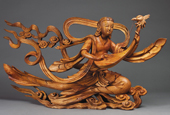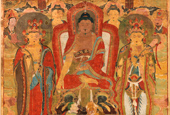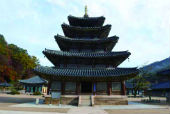Taoism, an ancient Chinese tradition of philosophy and religious belief, arrived in Korea during the ancient Three Kingdoms period (57 B.C.- A.D. 935). Since then, it has become one of the biggest Korean religious movements, along with Confucianism and Buddhism. However, compared with those two, or with indigenous folk beliefs, Taoism has always been less exposed in the academic world, and attracted little attention in social research. Korean Taoism, however, is not something that is a world-apart from our daily lives. It is in and amongst our day-to-day existence.
At least once in a lifetime, everybody dreams of immortality and eternal youth, a dream that can never be achieved. This dream-idea has its roots in Taoist ideology and culture.
The native Chinese religion and philosophical ideology got combined with theories of traditional East Asian medicine, such as the Yin and the Yang and the Five Elements, and then mixed again with elements of Buddhism and Confucianism when it arrived in Korea. These are the factors that shaped modern Korean Taoism.
Historical accounts suggest that the Tang Dynasty (618-907) began dispatching dosa, Taoist experts, to the Goguryeo Kingdom (37 B.C.- A.D. 668) in around the 7th century. In 643, upon a request from Goguryeo’s top military commander Yeon Gaesomun, Emperor Taizong of the Tang Dynasty (r. 626-649) is known to have sent a group of eight dosa who brought the Chinese classical text “Tao Te Ching,” written by the sage Laozi, to Korea for the first time.
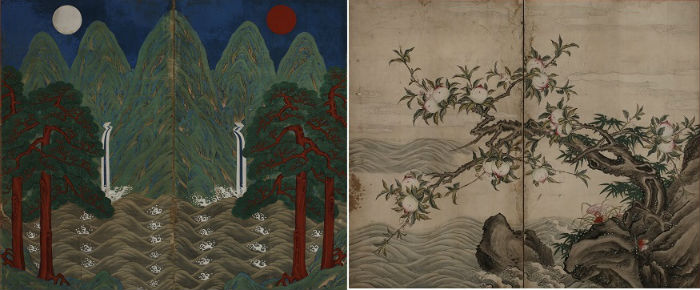
To bring all this history to modern light, the National Museum of Korea recently opened a rare exhibit, “Taoist Culture in Korea: The Road to Happiness.” It is almost the first, large-scale exhibition to focus on Taoism itself and its influences and how they have penetrated deeply into modern Korean culture and society.
Visitors to the exhibition will be given the rare chance to look into Taoism’s influences on Korea’s seasonal customs, religions, art, pop culture and health management.
The exhibition brings to visitors nearly 300 items, including sculptures, national treasures, paintings, craftwork, documents and archeological artifacts.

The exhibition consists of three sections. The first, “Taoist Deities and Rites,” shows artifacts that were used in Taoist temples and ceremonies as well as educational material about Taoist deities and worship practices. The second section, “Eternal Youth and Eternal Life,” sheds lights on how to become a Taoist. This section can probably be recognized as the highlight of the exhibition, thanks to the presence of the famous Baekje incense burner, National Treasure no. 287, on loan from the Buyeo National Museum. The final section is dedicated to paintings. On display are some masterpieces of painter Kim Hong-do from the late Joseon Dynasty (1392-1910). “Gunseondo,” or “Taoist Immortals,” painted in 1776, depicts 19 Taoist deities. It has been designated as National Treasure No. 139 and recognized as the definitive art work of the time.
Ever since the beginning of time, the Korean people have admired nature, such as the sky, earth and water. These beliefs are reflected in “Ilwonobongdo.” The painting features the moon in the top left, the sun in the top right and five mountain tops and trees, along with two waterfalls, in the middle. The pattern was often used on folding screens during the Joseon Dynasty. The “Seobandodo” on the back features bando, or peaches, a symbol of eternal life.
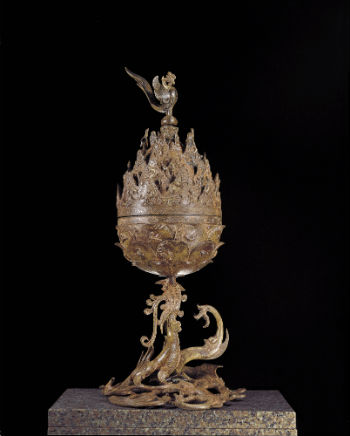 Also on display are items excavated from royal tombs that shed light on the customs of the time. The Jinmyosu is a statue of an imaginary creature resembling a pig, excavated from the Royal Baekje Muryeong Tomb. It was known to have been buried inside the tomb in order to protect the king from evil spirits, a tradition that is known to also be part of Chinese funeral customs.
Also on display are items excavated from royal tombs that shed light on the customs of the time. The Jinmyosu is a statue of an imaginary creature resembling a pig, excavated from the Royal Baekje Muryeong Tomb. It was known to have been buried inside the tomb in order to protect the king from evil spirits, a tradition that is known to also be part of Chinese funeral customs.
Finally, the must-see exhibit item is National Treasure No. 287, the Gilt-bronze Incense Burner of Baekje, on loan from the Buyeo National Museum. Though only used to burn incense, this work of art is elevated onto a higher plane by its four distinct segments: the lid, the body, the bonghwang phoenix-shaped knob and the support plate. At first glance, it looks like a dragon balancing a large lotus flower on its lips. Upon closer inspection, however, the artistic qualities reveal themselves and you can see that the national treasure is hiding a total of 16 people carved into the metal, playing musical instruments, fishing or in Seon (Zen) meditation, as well as a variety of animals such as tigers, deer, elephants and monkeys. The gilt-bronze masterpiece also includes trees, rocks, waterfalls and river streams. This fine work of Baekje art is 64cm high and 19cm in diameter.
The exhibition runs through March 2, 2014, and admission is free.
Detailed information can be found at the museum’s website: www.museum.go.kr
(All photos courtesy of the National Museum of Korea)
By Lee Seung-ah
Korea.net Staff Writer
slee27@korea.kr
At least once in a lifetime, everybody dreams of immortality and eternal youth, a dream that can never be achieved. This dream-idea has its roots in Taoist ideology and culture.
The native Chinese religion and philosophical ideology got combined with theories of traditional East Asian medicine, such as the Yin and the Yang and the Five Elements, and then mixed again with elements of Buddhism and Confucianism when it arrived in Korea. These are the factors that shaped modern Korean Taoism.
Historical accounts suggest that the Tang Dynasty (618-907) began dispatching dosa, Taoist experts, to the Goguryeo Kingdom (37 B.C.- A.D. 668) in around the 7th century. In 643, upon a request from Goguryeo’s top military commander Yeon Gaesomun, Emperor Taizong of the Tang Dynasty (r. 626-649) is known to have sent a group of eight dosa who brought the Chinese classical text “Tao Te Ching,” written by the sage Laozi, to Korea for the first time.

This royal decorative painting has the “Ilwolobongdo,” the Sun, Moon and Five Peaks, (left) on one side and the “Haebandodo,” Heavenly Peaches, on the flip side.
To bring all this history to modern light, the National Museum of Korea recently opened a rare exhibit, “Taoist Culture in Korea: The Road to Happiness.” It is almost the first, large-scale exhibition to focus on Taoism itself and its influences and how they have penetrated deeply into modern Korean culture and society.
Visitors to the exhibition will be given the rare chance to look into Taoism’s influences on Korea’s seasonal customs, religions, art, pop culture and health management.
The exhibition brings to visitors nearly 300 items, including sculptures, national treasures, paintings, craftwork, documents and archeological artifacts.

“Gunseondo” by Kim Hong-do was designated as National Treasure No. 139 in 1971.
The exhibition consists of three sections. The first, “Taoist Deities and Rites,” shows artifacts that were used in Taoist temples and ceremonies as well as educational material about Taoist deities and worship practices. The second section, “Eternal Youth and Eternal Life,” sheds lights on how to become a Taoist. This section can probably be recognized as the highlight of the exhibition, thanks to the presence of the famous Baekje incense burner, National Treasure no. 287, on loan from the Buyeo National Museum. The final section is dedicated to paintings. On display are some masterpieces of painter Kim Hong-do from the late Joseon Dynasty (1392-1910). “Gunseondo,” or “Taoist Immortals,” painted in 1776, depicts 19 Taoist deities. It has been designated as National Treasure No. 139 and recognized as the definitive art work of the time.
Ever since the beginning of time, the Korean people have admired nature, such as the sky, earth and water. These beliefs are reflected in “Ilwonobongdo.” The painting features the moon in the top left, the sun in the top right and five mountain tops and trees, along with two waterfalls, in the middle. The pattern was often used on folding screens during the Joseon Dynasty. The “Seobandodo” on the back features bando, or peaches, a symbol of eternal life.

National Treasure No. 287, the Gilt-bronze Incense Burner of Baekje is on loan from the Buyeo National Museum.
Finally, the must-see exhibit item is National Treasure No. 287, the Gilt-bronze Incense Burner of Baekje, on loan from the Buyeo National Museum. Though only used to burn incense, this work of art is elevated onto a higher plane by its four distinct segments: the lid, the body, the bonghwang phoenix-shaped knob and the support plate. At first glance, it looks like a dragon balancing a large lotus flower on its lips. Upon closer inspection, however, the artistic qualities reveal themselves and you can see that the national treasure is hiding a total of 16 people carved into the metal, playing musical instruments, fishing or in Seon (Zen) meditation, as well as a variety of animals such as tigers, deer, elephants and monkeys. The gilt-bronze masterpiece also includes trees, rocks, waterfalls and river streams. This fine work of Baekje art is 64cm high and 19cm in diameter.
The exhibition runs through March 2, 2014, and admission is free.
Detailed information can be found at the museum’s website: www.museum.go.kr
(All photos courtesy of the National Museum of Korea)
By Lee Seung-ah
Korea.net Staff Writer
slee27@korea.kr
